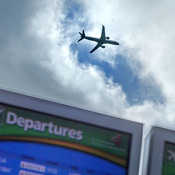As It Turns Extra-Tropical, Typhoon Nuri Could Challenge All-Time Record
NASA's Aqua satellite captured this image of Super Typhoon Nuri after it developed an eye on Nov. 3. NASA Goddard MODIS Rapid Response Team hide caption

NASA's Aqua satellite captured this image of Super Typhoon Nuri after it developed an eye on Nov. 3.
NASA Goddard MODIS Rapid Response TeamTyphoon Nuri has already had a remarkable run on this Earth.
The Capital Weather Gang explains that for 24 hours over the weekend, Nuri was a category 5 monster storm with maximum sustained winds of 180 mph, tying with Typhoon Vongfong as the strongest cyclone of the season.
But Nuri may actually make a name for itself after it loses its tropical characteristics when it moves north into the Bering Sea.
When it gets there, all the warm, tropical air it's pushing around will crash into a mountain of cold air and cause a violent explosion of meteorological energy that could propel this storm into history.
The National Weather Service in Anchorage says that during that so-called "bombogenesis" the storm's central pressure — an important measure of intensity — will deepen from 970 MB late Thursday to between 918 to 922 MB late Friday.
"That would create a significant event, as the current record lowest pressure observed in the Bering Sea is 925 MB, measured at Dutch Harbor on October 25, 1977," the NWS writes in its advisory.
What's more, a central pressure that low threatens the 913 MB all-time record for an extra-tropical storm set in the North Atlantic in 1993.
"For reference, the lowest central pressure of Hurricane Andrew (1992) was 922 millibars. Despite the potential of a similar pressure at its peak, wind speeds in extratropical cyclones such as the upcoming storm are much lower than hurricanes, because the pressure gradient is spread out over a much larger area than in a hurricane."
The National Weather Service says that the Aleutian Islands will be pummeled with 40 to 50 foot waves and wind gusts of up to 100 mph.
The Capital Weather Gang says this storm is so strong that it will also cause the jet stream to plunge south, bringing cold temperatures to a huge part of the U.S. They report:
"The storm's deep low pressure will build a strong ridge in the eastern Pacific and over western North America. This, in turn, will force cold, Arctic air to surge south in the central and eastern U.S. over the next few weeks.
"The first in a series of strong cold fronts is expected on Friday, while forecast models suggest a deeper push of cold air can be expected next week."
Comments
You must be signed in to leave a comment. Sign In / Register
Please keep your community civil. All comments must follow the NPR.org Community rules and terms of use, and will be moderated prior to posting. NPR reserves the right to use the comments we receive, in whole or in part, and to use the commenter's name and location, in any medium. See also the Terms of Use, Privacy Policy and Community FAQ.







